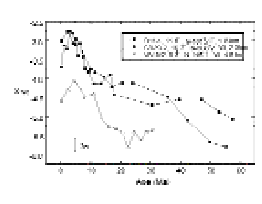
Hydrogeneous ferromanganese crusts develop upon oceanic seamounts and appear to incorporate ambient seawater Nd, Pb and Be isotopes amongst others. Of the various methods explored in attempts to derive a reliable chronology for ferromanganese crusts 10Be has so far proved to be the most reliable and generally applicable.
Three ferromanganese crusts from central Pacific seamounts have been analysed for 10Be/9Be, 143Nd/144Nd and 207,206,208Pb/204Pb as a function of depth in the crusts. 10Be/9Be ratios show a smooth variation within the crusts which for crusts D11-1 (161.7ƒE-11.6ƒN) and CD29-2 (168.2ƒW-16.7ƒN) give growth rates of 1.37 to 2.7 and 2.1 mm/Ma respectively. The third crust VA13/2, analysed by Segl et al. (1984) gives a 10Be growth rate of 2.7 to 4.8 mm/Ma. Extrapolation of these growth rates to the base of the crusts suggests commencement of crust growth at ~55 Ma. The variation of eNd with age for the three crusts is shown in Fig.1. The eNd values of the crust surfaces are well within the present-day Pacific seawater composition at water depths corresponding to present-day depths of the crusts (Piepgras and Jacobsen, 1988). 206Pb/204Pb ratios for the same time intervals are show in Fig. 2. A notable feature of all three crusts is a well-resolved change from increasing eNd 3-5 Ma followed by a decrease towards the present day. In addition crust VA13/2 from the greatest water depth (4.8 km) has lower eNd at all ages than the other two crusts from shallower depths (~2 km). These observations suggest that the Pacific has been stratified in eNd over some 20-30 Ma or more. The more negative eNd values and more radiogenic Pb isotopes in the past in the Pacific appear to correspond to input of Nd and Pb from continental sources more akin to that supplying Nd and Pb to the Atlantic. The 3-5 Ma structure evident in eNd, but not the Pb isotopes (Figs. 1, 2), appears to correspond to closure Panamanian gateway which restricted and closed off east-west water exchange between the Atlantic and Pacific. This difference between Nd and Pb isotopes appears to reflect the effects of different residence times of the two elements in seawater.
Piepgras, D.J. & Jacobsen, S.B., Geochim. Cosmochim. Acta 52, 1373-1381 (1988).
Segl, M. et al., Nature 309, 540-543 (1984).
Fig. 1: *Nd vs. age of Fe-Mn crusts from the central Pacific.
Fig. 2: 206Pb/204Pb vs. age of Fe-Mn crusts from the central Pacific.